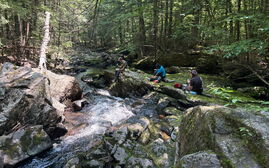Restaurant reopenings will be limited to outdoor seating in three Maine counties
 Photo / Renee Cordes
Restuarants in Cumberland, York and Androscoggin counties will have to wait until they can offer indoor dining, as COVID-19 cases and hospitalizations increase in those counties.
Photo / Renee Cordes
Restuarants in Cumberland, York and Androscoggin counties will have to wait until they can offer indoor dining, as COVID-19 cases and hospitalizations increase in those counties.
Restaurants in Cumberland, York and Androscoggin counties can only reopen to outside dining Monday, following an increase in COVID-19 hospitalizations and case counts in those counties.
The initial reopening plan tentatively allowed restaurants to open fully Monday, June 1, with spacing and other restrictions, but Gov. Janet Mills said Wednesday that the numbers won't allow it. No new date has been determined for when restaurants can allow diners to eat in.
"I know this is not welcome news for restaurants that were preparing to fully open next week," Mills said at Wednesday's daily COVID-19 briefing. She said the decision is in the "best interest of public health," while balancing the economic hardship restaurant owners are experiencing.
Penobscot County, which is among the four counties that couldn't reopen restaurants until Monday will be able to go ahead and allow indoor seating. Although the county, which includes Bangor, has had community transmission — spread of virus among random people — it has not had more than three new cases a day since April. Restaurants in the other 12 counties could reopen to indoor seating May 18.
Mills urged the municipalities in the three counties to look at closing off streets and other creative ways to allow restaurants to make room for outdoor dining, plans Portland and Rockland have already discussed. The Department of Health and Human Services and Department of Administrative and Financial Services, both of which have licensing oversight of restaurants, are expediting the licensing process for outdoor dining, she said.
Criticism, alternate plans
The announcement, made five days before many restaurants in the three counties were poised to reopen, was criticized by many.
“This comes at the worst possible time and will bring significant consequences for businesses that are already struggling to survive.” said Auburn Mayor Jason Lavesque in a news release. “Our local restaurants were counting on reopening on June 1. City staff have been working closely with them on outdoor seating and CDC guidelines that will protect their staff as well as patrons.”
Steve Hewins, CEO of HospitalityMaine, has been working with the state on reopening for both restaurants and lodging. While members aren't happy, he said they have to defer to the governor. The organization is also encouraging members to look at take-out and outdoor dining options.
Some restaurants, though, weren't planning to open even before the announcement.
"We will not open right away in June," owners of Vinland, in Portland, posted on Facebook last week. "Maine’s COVID numbers are rising rapidly and we’re just starting to see a flood of tourists from states with much higher infection rates. We wish the absolute best of luck to our colleagues who are choosing to do their best to operate safely, but we on the Vinland team are in agreement that any dine-in service is just too unsafe at this stage."
The Portland Food Map website also notes many restaurants are still planning to open with outdoor service. It posts a list, frequently updated, of those that will serve outdoors and the dates they'll reopen.
Hotels, others still on track
Hotels and other businesses that could reopen in Phase 2, as well as churches and other gatherings of 50 or less, are still all right to open Monday, with adherence to the checklists provided by the state on the Department of Community and Economic Development website.
Nirav Shah, director of the Maine CDC, said that restaurants are different in that people who stay in one place for a long period of time indoors, which is an environment that spreads the virus, as opposed to lodgings and other businesses where people are moving around and not clustered in large numbers.
“It’s not just so much the location but the type of activity,” he said. With indoors dining, "You have a high-density environment with a longer duration of exposure. Those two things are different say, from jogging outside in the park.”
About 90% of the state's COVID-19 cases are in the three counties, which are the state's most populous with nearly half of Maine's 1.3 million residents. Shah said that the number of cases per capita in those counties is higher than in other counties as well. For instance, Cumberland County has 36 cases per 10,000 residents, compared to 0.6 in Piscataquis County.
While many of those cases are in congregant care settings, particularly nursing homes, Mills said that doesn't mean the rest of the community is affected.
"[COVID-19] doesn’t grow in flower pots in the nursing homes," she said. "It comes from the community, it comes from outside."
She also said Wednesday that the state is still, for now, committed to the 14-day quarantine required of out-of-state visitors, which she called the best tool available. The two weeks is based on when symptoms would generally show up.
"We have an influx of as many of 10 to 20 million people into the state of Maine," she said. "We're looking at 10, 20 million coming here from what are high-intensity outbreak areas."
The state continues to look at other ways to monitor out-of-staters who may spread the virus further in the state, she said, including expanded testing, drive-through testing, thermometers and other symptom measurements for businesses, churches and other places that those from out of state may go, and also how other states are handling it.
What can open Monday
A variety of businesses and activities can open or begin Monday in all 16 counties. All have a variety of guidelines, which checklists, for social distancing, monitoring and health and safety, available on the state's COVID-19 checklists page:
- Retail businesses in York, Cumberland, Androscoggin, and Penobscot counties, which have been closed to indoor shopping, can let customers inside. The other 12 counties opened earlier this month.
- Public gatherings of 50 or less.
- Public and community buildings, with limits to how many people can be inside.
- Museums, with limits to the number of visitors, ranging from five for space of less than 7,500 square feet to 100 for those with 60,000 square feet or more.
- Lodging in all 16 counties open to Maine residents, as well as out-of-state residents who have quarantined for 14 days.
- Campgrounds and RV parks opened to Maine residents May 22; out-of-state residents who have completed quarantine guidelines may camp beginning Monday. This includes state park campgrounds and day camps.
- Coastal state parks will open, with limited services.
- Community sports, if outdoors, as well as outdoor pools.
- Motorcycle and ATV safety programs.
- Summer education programs.
Still being considered for indoors opening in June, but with no date set, are personal services, fitness and exercise gyms, nail technicicians and tanning salons
A fluid situation
Despite the uptick in cases and hospitalizations, the state's hospital capacity and readiness – including the availability of ICU beds, non-ICU beds and ventilators – remains adequate, according to a Mills news release.
Adjusted for population size, Maine as of Wednesday ranked tenth-lowest in the nation in terms of positive cases; No. 39 in deaths; No. 30 in patients hospitalized over the course of the pandemic (out of the 35 states reporting); and No. 17 in the percentage of people who have recovered (out of 41 states reporting).
State and health officials say that the reopening situation will continued to be reviewed as the state works on better determining the course of the virus. In the past weeks, the state has tripled testing capacity through a partnership with IDEXX Laboratories and eliminated testing prioritization, so that now anyone suspected of having COVID-19 can be tested.
It has also expanded the contact tracing system — the ability to determine who someone with the virus has had contact with — and plans to hire up to 125 people to help with the effort. It also received federal money to expand the state's lab capacity, bolster rural hospital lab capacity,and establish drive-through testing sites, which will ramp up as availability of resources needed for testing loosens up.













0 Comments